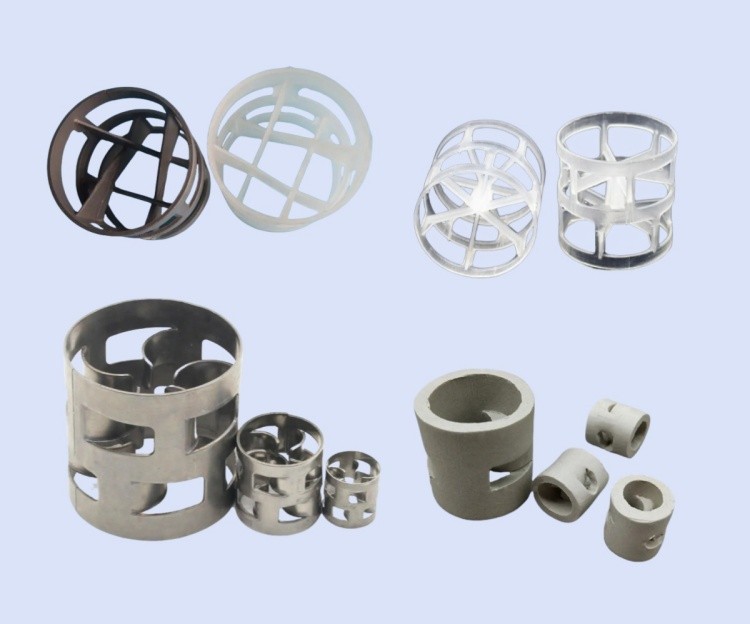Pall ring is also named Pall ring packing. lt has a unique multiple-blade design, which relatively enlarges the internal surface area and promotes the fluid-air exchange. Pall rings is improved on the basis of the raschig ring's structure. The Pall Ring can be considered to be the most widely used random packing. Given the limited availability of detailed information on Pall Rings, we attempt to provide you with a comprehensive understanding of Pall Rings through this article.
1.Pall Ring's introduction
The history of Pall ring packing dates back to the early 20th century, evolving from the earlier Raschig ring design. The Raschig ring, invented by the German chemist Friedrich Raschig in 1914, was a simple cylindrical packing used to enhance the efficiency of gas-liquid contact in distillation towers and reactors. The design of the Raschig ring was quite basic, being a cylinder of equal height and diameter without any internal structures to promote mixing or distribution between the gas and liquid phases.
Building on the Raschig ring, the Pall ring was developed in the 1950s to address some of the limitations encountered with Raschig rings, such as higher pressure drops and lower efficiency. Pall rings introduced openings and internal structures on the wall of the rings, improving gas-liquid distribution and thereby increasing mass transfer efficiency and operational flexibility. These openings allowed for more free flow of liquids and gases within the packing layer, while the internal structures increased the surface area for gas-liquid contact.
2.Structural characteristics of Pall ring packing are as follows
Ring Design: Pall ring packing features a ring-shaped design, resembling a cylindrical shape. This design helps to provide a large surface area and optimize the layout of the packing in the tower, enabling more efficient mass transfer and separation processes.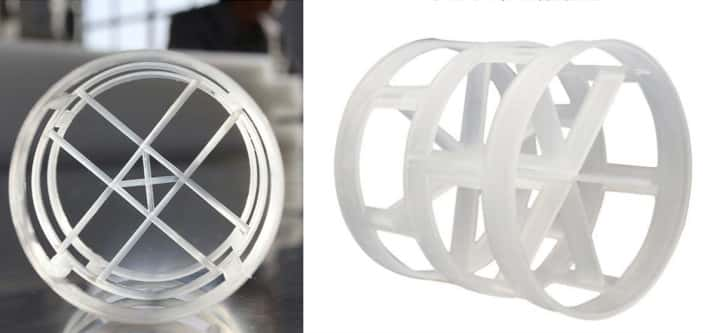
Internal Windows and Horizontal Fins: Pall ring packing typically includes multiple small windows or horizontal fins on the inside. These windows and fins contribute to increasing the surface area of the packing and providing pathways between packing layers, facilitating the exchange and distribution of liquids and gases.
Open Structure: Pall ring packing usually adopts an open structure design, where the surface of the rings is not completely sealed but contains multiple open perforations. This design helps to reduce pressure drop and lower the resistance of liquids or gases within the packing layers, thereby enhancing mass transfer efficiency.
Stacked Arrangement: Pall ring packing is often arranged in a stacked manner within the packing tower, forming multiple layers of packing beds. This arrangement maximizes the surface area of the packing and optimizes the gaps between the packing, resulting in more effective material transfer and separation.
Overall, the structural characteristics of Pall ring packing include ring design, internal windows and horizontal fins, open structure, stacked arrangement, and material selection, all of which collectively ensure the efficiency and reliability of the packing in industrial applications.
3.The Importance of Pall Rings in Industrial Applications
Pall rings play a pivotal role in various industrial processes, offering several advantages that make them indispensable in numerous applications. Here are some key reasons why pall rings are significant in industrial contexts:
Enhanced Mass Transfer: Pall rings are designed to provide increased surface area compared to traditional packing materials. This enhanced surface area facilitates more efficient mass transfer processes, such as absorption, distillation, and reaction, leading to improved separation and purification efficiencies.
Low Pressure Drop: Pall rings are engineered to minimize pressure drop within packed columns or towers. This characteristic is particularly beneficial in applications where maintaining a low-pressure environment is crucial for optimizing energy efficiency and operational costs.
Versatility: Pall rings are available in various materials, including stainless steel, carbon steel, and plastics, offering versatility in addressing diverse chemical and environmental conditions. This versatility allows for tailored solutions to specific industrial requirements.
Resistance to Fouling: The design of pall rings incorporates features such as internal windows and horizontal fins, which help mitigate fouling by preventing the accumulation of solids or liquids. This resistance to fouling ensures prolonged operational efficiency and reduces the frequency of maintenance shutdowns.
Environmental Applications: Pall rings are widely employed in environmental engineering applications, such as gas scrubbing and wastewater treatment. Their high surface area and efficient mass transfer characteristics enable effective removal of pollutants and contaminants from gas and liquid streams, contributing to environmental protection and regulatory compliance.
Durability and Longevity: Pall rings are constructed from durable materials capable of withstanding harsh operating conditions, including high temperatures, corrosive chemicals, and mechanical stresses. Their robustness and longevity make them a reliable choice for long-term industrial processes.
Cost-Effectiveness: While pall rings may involve higher initial investment compared to some alternative packing materials, their superior performance, durability, and reduced maintenance requirements often result in long-term cost savings. Additionally, the enhanced efficiency offered by pall rings can lead to higher productivity and product quality, further enhancing their cost-effectiveness.
Overall, the significance of pall rings in industrial applications lies in their ability to improve process efficiency, minimize operational costs, and ensure environmental compliance across a wide range of industries and processes. Their unique design features and versatile properties make them an indispensable component in modern industrial operations.
4.what are pall rings used for ?
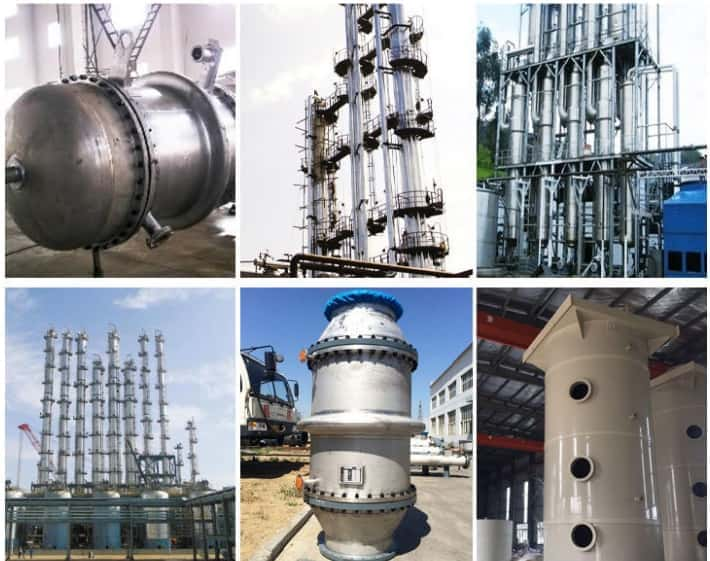
Pall rings are used for various industrial applications due to their efficiency in mass transfer, resistance to fouling, and versatility. Some common uses of pall rings include:
Gas Absorption: Pall rings are often employed in gas absorption processes to remove specific components from gas streams. They facilitate the transfer of gas components into a liquid phase for absorption, purification, or chemical reaction.
Distillation: In distillation columns, pall rings serve as effective packing materials for separating liquid mixtures into their individual components based on differences in volatility. They provide ample surface area for vapor-liquid contact, enhancing separation efficiency.
Liquid-Liquid Extraction: Pall rings aid in liquid-liquid extraction processes, where they promote the transfer of one liquid phase into another immiscible liquid phase. This facilitates the extraction of desired components from the original liquid phase.
Reaction Catalysis: Pall rings are utilized in catalytic reactors to facilitate chemical reactions by providing a large surface area for catalytic material deposition. They help in maximizing the contact between reactants and catalysts, thereby enhancing reaction rates and efficiency.
Heat Transfer: Pall rings can also be used as packing materials in heat exchangers, where they facilitate efficient heat transfer between two fluid streams. Their high surface area and open structure promote effective heat exchange, making them suitable for various heating and cooling applications.
Water Treatment: Pall rings are employed in water treatment processes, such as wastewater treatment and water purification, to facilitate the removal of pollutants, contaminants, and dissolved substances from water streams. They provide an effective medium for enhancing mass transfer and improving water quality.
Air Pollution Control: Pall rings play a role in air pollution control systems, where they are used in packed bed scrubbers to remove pollutants from industrial gas streams. They facilitate the absorption or adsorption of contaminants onto a liquid phase, resulting in cleaner emissions.
Hydrocarbon Processing: In the oil and gas industry, pall rings are utilized in processes such as dehydration, desulfurization, and hydrocarbon recovery. They help in separating hydrocarbon mixtures and removing impurities to meet product specifications.
Overall, pall rings find extensive use in industries such as chemical processing, petrochemicals, environmental engineering, and water treatment due to their effectiveness, durability, and versatility in various applications involving mass transfer and separation processes.
5.Pall ring packing material selection
Pall rings are made from various materials, including metals (such as stainless steel), plastics (such as polypropylene, PVC, and PVDF), and ceramics, depending on the specific requirements of the application, including temperature, chemical compatibility, and physical durability. The choice of material affects the performance, resistance to chemical attack, and the operating temperature range of the pall rings in the column. Selecting the appropriate material for Pall ring packing is crucial for optimizing process efficiency, durability, and cost-effectiveness in a packed column. The material choice depends on several factors, including chemical compatibility, operating temperature, mechanical strength, and cost. Here's an overview of common materials used for Pall rings and their typical applications:
Selecting the appropriate material for Pall ring packing is crucial for optimizing process efficiency, durability, and cost-effectiveness in a packed column. The material choice depends on several factors, including chemical compatibility, operating temperature, mechanical strength, and cost. Here's an overview of common materials used for Pall rings and their typical applications:
1. Metal Pall Rings
Materials: Stainless steel, carbon steel, aluminum, copper, nickel, and titanium.
Applications: Suitable for high-temperature applications and environments with corrosive chemicals. stainless steel pall rings are widely used due to their resistance to a broad range of chemicals and temperatures.
Advantages: High mechanical strength and durability, suitable for high-pressure and high-temperature processes.
Limitations: metal pall ring Higher cost than plastic pall rings, susceptibility to corrosion (depending on the metal), and heavier, which may require more robust support structures.
2. Plastic Pall Rings
Materials: Polypropylene (PP), polyethylene (PE), Polyvinyl chloride (PVC), Chlorinated polyvinyl chloride (CPVC), and Polytetrafluoroethylene (PTFE).
Applications: Used in low to medium temperature applications and where chemical resistance is essential. PP and PVC Pall rings are common for water treatment and scrubbing applications.
Advantages: Excellent chemical resistance, lightweight, and lower cost compared to metal Pall rings. Suitable for a wide range of chemical environments and less prone to chemical attack.
Limitations: Limited use in high-temperature applications. Mechanical strength is lower than metal Pall rings, which may not be suitable for high load conditions.
3. Ceramic Pall Rings
Materials: Various types of ceramics.
Applications: Ideal for very high temperatures and highly corrosive environments. Commonly used in acid scrubbing and other applications where metals and plastics may fail.
Advantages: Excellent resistance to thermal shock, high temperatures, and corrosive chemicals. Very durable and can handle very aggressive chemical environments.
Limitations: Fragility compared to metal and plastic Pall rings. The weight of ceramic rings requires careful consideration of the support structure within the column.
Selection Criteria:
Chemical Compatibility: The material should be resistant to the chemicals present in the process stream to avoid degradation.
Operating Temperature and Pressure: The selected material must withstand the process's temperature range and pressure conditions.
Cost-Effectiveness: Consider both the initial cost and the lifetime cost, including maintenance, replacement, and operation efficiency.
Physical Durability: The material should have sufficient mechanical strength to resist wear, breakage, and deformation under operating conditions.
The pall ring packing selection process involves balancing these factors to achieve optimal performance and cost-effectiveness. Consulting with material and process experts or referring to chemical resistance charts and material datasheets can provide valuable guidance in selecting the appropriate Pall ring material for a specific application.
6.Pall ring specification detail
Pall rings are a widely used type of packing material in packed towers to enhance mass transfer efficiency. Their design aims to provide a higher surface area for gas-liquid contact while reducing pressure drop. The performance parameters of Pall rings include dimensions, surface area, void fraction, pressure drop, mass transfer efficiency, and others. Here is a detailed explanation of some key parameters of Pall rings:
6.1 Dimensions
The dimensions of Pall rings typically refer to their diameter and height, with common sizes including10mm,16mm, 25mm, 38mm, 50mm, 76mm even 100mm etc. The choice of size depends on the size of the tower and processing requirements.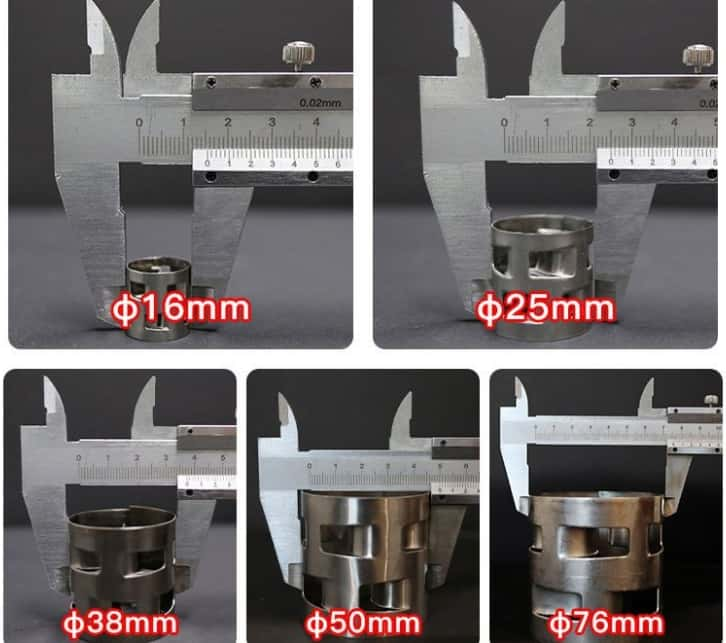
6.2 Pall Ring’s Surface Area
The surface area is the effective contact area provided by Pall rings per unit volume, usually measured in square meters per cubic meter (m²/m³). A larger surface area increases the efficiency of gas-liquid contact but may also lead to an increase in pressure drop.
6.3 Pall Ring’s Void Fraction
The void fraction refers to the volume of spaces within the packing layer as a percentage of the total volume, reflecting the porosity of the packing layer. A high void fraction helps reduce pressure drop and promotes gas-liquid flow. The typical range of void fraction is between 90% and 95%.
6.4 Pall ring Pressure Drop
Pressure drop is the loss of pressure as gas passes through the packing layer, typically measured in millimeters of water column (mmH2O) or Pascals (Pa). The pressure drop depends on the airflow speed, the size, shape, and arrangement of the packing. Design efforts aim to balance efficiency and pressure drop.
6.5 Mass Transfer Efficiency of pall riing
Mass transfer efficiency refers to the efficiency with which Pall rings facilitate mass transfer between gas and liquid under given conditions. This usually relates to the packing's surface area, shape, and the distribution capabilities of the material.
6.6 Mechanical Strength
Mechanical strength refers to the ability of Pall rings to maintain their shape and functionality under pressure and temperature changes. Metal Pall rings typically offer higher mechanical strength compared to plastic and ceramic pall rings.
6.7 Chemical Stability
Chemical stability refers to the resistance of Pall ring materials to chemical corrosion and dissolution. Different materials make Pall rings suitable for different chemical environments.
6.8 Operating Temperature Range
The operating temperature range is the range within which Pall rings can work stably. Metal Pall rings can typically operate at higher temperatures, whereas plastic and ceramic Pall rings are suitable for lower temperature ranges.
6.9 Wettability
Wettability refers to the ability of liquids to spread over the surface of Pall rings, directly affecting the efficiency of gas-liquid contact. Good wettability helps improve mass transfer efficiency.
6.10 Pall Ring Packing Density
Packing density refers to the weight of packing material per unit volume of the column and is typically expressed in kg/m³. The packing density of Pall rings varies with the material and size of the rings:
Metal Pall Rings: Higher density, typically in the range of 400 to 800 kg/m³.
Plastic Pall Rings: Lower density, generally between 100 to 300 kg/m³.
Ceramic Pall Rings: Vary significantly based on the type of ceramic, but generally higher than plastic and can be similar to or exceed that of metals.
6.11 Pall Ring Packing Factor
The packing factor, or packing "F factor," is a measure used to estimate the performance of the packing in terms of pressure drop and mass transfer efficiency. It is influenced by the size, shape, and surface area of the packing material. The packing factor is usually given in units of m^-1 and is used in conjunction with operating conditions (like flow rates and fluid properties) to estimate column performance.
Higher Packing Factors: Indicate a greater surface area for mass transfer but can also result in higher pressure drops.
Lower Packing Factors: Suggest less resistance to fluid flow, which may reduce pressure drop but also decrease the surface area available for mass transfer.
The specific packing factor for Pall rings must be selected based on the balance between desired mass transfer efficiency and acceptable pressure drop, considering the specific process requirements and the physical properties of the fluids being processed.
6.12 Metal Pall Ring Specification 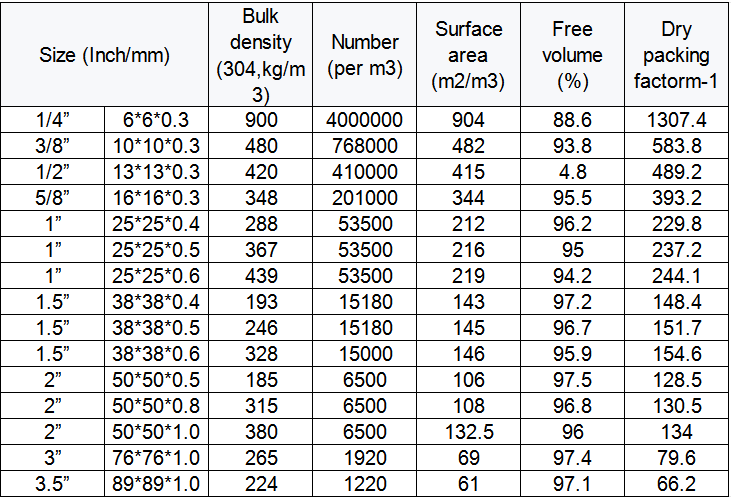
6.13 Ceramic Pall Ring Specification 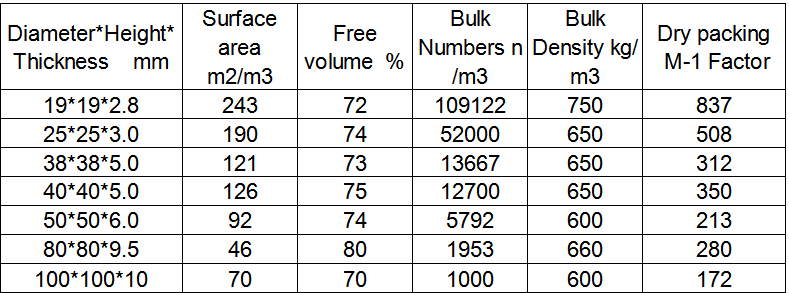
6.13 Plastic Pall Ring Specification 
7.Advantages and Disadvantages of Pall Rings
Pall rings, as a type of industrial packing, are widely used in various separation and absorption processes, offering unique advantages and some potential disadvantages. Here is a summary of the advantages and disadvantages of Pall rings:
Advantages of Pall Rings
Enhanced Mass Transfer Efficiency: The open structure design of Pall rings increases the contact area between gases and liquids, thus enhancing mass transfer efficiency.
Low Pressure Drop: Compared to other types of packing, Pall rings have a lower pressure drop due to their unique design, which helps reduce operating costs.
High Operational Flexibility: Pall rings can effectively operate across a wide range of conditions, including different flow rates and temperatures.
High Void Fraction: The high void fraction of Pall rings promotes good gas-liquid distribution, reducing the risk of blockage and liquid hold-up.
Suitable for Various Materials: Pall rings can be made from different materials (such as plastic, metal, and ceramic) depending on the chemical and physical operating conditions.
Ease of Cleaning and Maintenance: The structure of Pall rings facilitates easy cleaning and replacement, helping to lower long-term maintenance costs.
Disadvantages of Pall Rings
Physical Durability: Plastic and ceramic Pall rings may not be as durable as metal Pall rings under extreme temperature or chemical corrosion conditions.
Initial Cost: The initial investment for Pall rings, especially those made from specialty metals, can be relatively high.
Operational Limitations: Although Pall rings are suitable for a wide range of operating conditions, special materials or design considerations may be required in the presence of extreme pressures, temperatures, or corrosive chemicals.
Efficiency Dependent on Material and Size Selection: The efficiency of Pall rings largely depends on the correct choice of material and size; incorrect selection can lead to poor efficiency or high operating costs.
Quality Control: The quality of Pall rings on the market can vary significantly; low-quality Pall rings may decrease process efficiency and operational stability.
Conclusion
Above all when selecting Pall ring packing for a particular application, it's crucial to consider the specific specifications, including dimensions, material, packing density, and packing factor, to ensure optimal column performance for the intended separation or reaction process.
